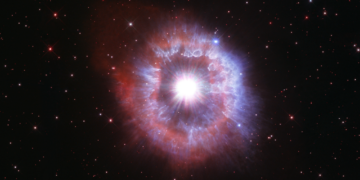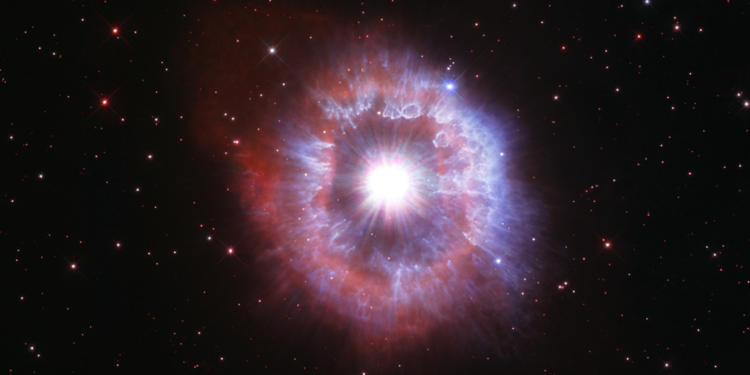The “Hubble tension” is one of cosmology’s biggest puzzles—a conflict between different measurements of the universe’s expansion rate. A new theory suggests Earth resides in a massive cosmic void, potentially explaining this discrepancy and reshaping our understanding of the cosmos.
Recent Advancements in Understanding the Hubble Tension
The “Hubble tension,” a major puzzle in modern cosmology, refers to a significant discrepancy in the measured expansion rate of the universe, known as the Hubble constant (H₀). This tension arises because different methods of measuring H₀ yield inconsistent results. Early-universe observations, such as the cosmic microwave background (CMB), suggest a lower H₀ value, while local measurements using supernovae and Cepheid variables indicate a higher rate. This discrepancy challenges the standard cosmological model, known as ΛCDM (Lambda-Cold Dark Matter), and has sparked intense debates among scientists.
A new hypothesis offers an intriguing explanation for this tension. It suggests that our position within a vast, under-dense region of space, called the Keenan-Barger-Cowie (KBC) void, could be distorting local measurements.
Understanding the Hubble Tension
The Hubble constant (H₀) measures how fast the universe is expanding. Astronomers use two main approaches to determine its value. The first method relies on early-universe observations, particularly the CMB. This faint glow of radiation, left over from the Big Bang, carries imprints of the universe’s initial conditions. Detailed analyses of the CMB reveal a lower H₀ value, suggesting a slower expansion rate.
The second method involves local measurements, such as observing distant supernovae and Cepheid variables. These cosmic “standard candles” allow astronomers to measure distances accurately and calculate H₀ by comparing redshift—how much light stretches as the universe expands—with distance. This approach consistently yields a higher H₀ value, indicating a faster expansion rate.
The discrepancy between these two measurements is significant—about 8%—and far exceeds the margin of error. This conflict has become one of the most pressing issues in cosmology, leading some researchers to question the completeness of the ΛCDM model.
The KBC Void Hypothesis
The Keenan-Barger-Cowie (KBC) void is a massive under-dense region of space, spanning approximately 2 billion light-years and encompassing the Milky Way and much of the Laniakea Supercluster. This void contains fewer galaxies and less matter than the cosmic average, creating a local underdensity that could affect measurements of the Hubble constant.
In regions of lower density, gravity is weaker, and matter flows outward toward denser areas. This creates “peculiar velocities”—motions that deviate from the general cosmic expansion. These velocities could artificially inflate local redshift measurements, making the universe appear to expand faster locally than it does on average.
The KBC void’s influence might explain why local H₀ measurements are consistently higher than those derived from the early universe. This hypothesis aligns with observed patterns in galaxy distributions and peculiar velocity fields, suggesting that the Hubble tension could be a local phenomenon rather than a fundamental flaw in cosmological theory.
Recent Studies and Findings
Recent studies have tested the KBC void hypothesis by modeling the velocity field it would create in the nearby universe. These models predict peculiar velocity patterns that align closely with observed bulk flows—the average motion of matter within large cosmic volumes. Bulk flow measurements, taken within spheres of increasing radii, provide critical insights into the universe’s large-scale structure and dynamics.
The results show that the KBC void could account for the higher local H₀ values without requiring modifications to the ΛCDM model. However, the existence of such a large void challenges the assumption of homogeneity—the idea that the universe is uniformly distributed on large scales.
Implications for Cosmology
The KBC void hypothesis has far-reaching implications for our understanding of the universe. If local cosmic structures like the KBC void significantly influence H₀ measurements, it suggests that the universe is more complex and varied than previously thought. This complexity could impact other areas of cosmology, such as the distribution of dark matter and the formation of large-scale structures like galaxy clusters and superclusters.
The existence of the KBC void also challenges the ΛCDM model, which assumes that gravity operates uniformly across all scales. To account for the KBC void, some researchers propose modifications to the standard model, such as altering the strength of gravity on large scales or considering alternative theories like Modified Newtonian Dynamics (MOND). These adjustments could address the Hubble tension and other unexplained phenomena, such as the unexpected distribution of galaxy clusters and the observed patterns of baryon acoustic oscillations (BAOs).
Testing the Hypothesis
To validate the KBC void hypothesis, scientists are conducting additional tests using independent observational methods. One promising approach involves studying BAOs, which are ripples in the distribution of galaxies caused by sound waves in the early universe. These ripples create a “standard ruler” that can be used to measure distances and chart the universe’s expansion history.
If the KBC void exists, it should distort the relationship between redshift and the BAO angular scale in the local universe. Preliminary BAO measurements show deviations consistent with this prediction, providing indirect support for the KBC void hypothesis. However, further data and analysis are needed to confirm these findings and rule out alternative explanations.
Another test involves analyzing the distribution of galaxy clusters and their velocities. Galaxy clusters in and around the KBC void should exhibit peculiar velocity patterns that reflect the void’s influence. High-precision measurements of these patterns could provide definitive evidence for or against the void’s existence.
Challenges and Controversies
Despite its potential to resolve the Hubble tension, the KBC void hypothesis faces significant challenges. One major issue is its inconsistency with the ΛCDM model’s predictions. According to ΛCDM, the universe should be homogeneous and isotropic on large scales, with only minor variations in density. The KBC void’s size and depth exceed these predictions, suggesting that standard cosmology might not fully capture the complexity of the universe.
Moreover, some researchers argue that the Hubble tension might not be related to local cosmic structures at all. They propose alternative explanations, such as new physics beyond the standard model or errors in data calibration. Resolving these debates requires a combination of theoretical advancements and high-precision observations.
Conclusion
The KBC void hypothesis offers a compelling explanation for the Hubble tension, suggesting that local cosmic structures could significantly impact our measurements of the universe’s expansion rate. While this approach provides a potential resolution to one of cosmology’s biggest puzzles, it also challenges existing models and raises new questions about the universe’s structure and dynamics.
Reference:
Sergij Mazurenko et al, A simultaneous solution to the Hubble tension and observed bulk flow within 250 h−1 Mpc, Monthly Notices of the Royal Astronomical Society (2023). DOI: 10.1093/mnras/stad3357



















